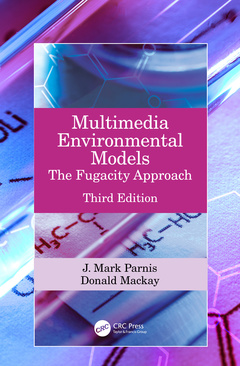Description
Multimedia Environmental Models (3rd Ed.)
The Fugacity Approach
Authors: Parnis J. Mark, Mackay Donald
Language: English
Subjects for Multimedia Environmental Models:
Keywords
mass; transfer; coefficient; chemical; fate; balance; equations; fugacity; diagram; partition; multimedia environmental modeling; equilibrium partitioning; fugacity approach; dynamic open systems; octanol–water partitioning; Mol Pa; Basic Physico Chemical Properties; Fugacity Ratio; Fugacity Capacity; Concentration Decay Curve; Partition Ratio; Level Iii; Henry's Law Constant Values; Lethal Concentration; Air Water Interface Area; Food Web Model; Pa Mol; PBPK Model; High Throughput Screening; Chemical Exposure; Evaluative Environment; Level Ii; Loss Rate Constant; Level Iv; Advective Flow; Growth Dilution; Steady State Uptake; Constant Water Concentration
Publication date: 02-2022
· 17.8x25.4 cm · Paperback
Publication date: 09-2020
· 17.8x25.4 cm · Hardback
Description
/li>Contents
/li>Readership
/li>Biography
/li>
Multimedia Environmental Models: The Fugacity Approach, Third Edition, takes a broad approach of viewing chemical behavior in the total biosphere of connected biotic and abiotic compartments. Chemicals are subject to the laws of "mass balance," a constraint that provides the opportunity to establish quantitative expressions for chemical fate that are central to chemical management and regulatory legislation.
This book employs both the conventional concentration-based procedures and those based on application of the more elegant and powerful concept of fugacity to characterize equilibrium, steady-state distribution, and time-dependent transport between environmental phases such as air, water, and soil. Organic chemicals are emphasized because they are more easily generalized when assessing environmental behavior.
Features
- Illustrates professional approaches to calculating the fate of chemicals in the environment
- Explicitly details all worked examples in an annotated step-by-step fashion
- Presents real-life freely downloadable models of use to government, industry, and private consulting professionals and students alike
- Clarifies symbols and notation
1. Basic Concepts 2. Equilibrium Partitioning 3. Advection and Reaction 4. Transport within and between Compartments 5. Evaluative Fugacity Models and Calculations 6. Specific Fugacity Models and Calculations 7. Chemical Uptake by Organisms 8. Human Health
J. Mark Parnis is a physical chemist with a background in quantum mechanics, spectroscopy, and kinetics. Born in Calgary, Alberta, Mark graduated from the University of Toronto with a PhD in physical inorganic chemistry. After working in the NRC Laser Chemistry Group in Ottawa, he joined Trent University Chemistry Department in 1989, where he has taught inorganic, physical, and theoretical chemistry. Early on in his research career, he worked on the photochemistry and spectroscopic characterization of metal atom reaction products with small organic molecules in low-temperature matrices. This work led to studies of organic cation spectroscopy and the study of ion decomposition products in matrices. Later in his career, he joined forces with Donald Mackay to form the Chemical Properties Research Group, focusing on the techniques for estimating physicochemical properties of molecular species with an emphasis on environmental modeling applications. He is currently the director of the Canadian Environmental Modelling Centre at Trent University.
Donald Mackay is an internationally renowned engineer and scientist, the acknowledged pioneer of fugacity-based modeling applications in environmental fate and exposure methodology. Born in Glasgow, Scotland, Don is a graduate of the University of Glasgow and is now professor emeritus in the School of the Environment and director emeritus of the Canadian Environmental Modelling Centre, both at Trent University. He is also professor emeritus in the Department of Chemical Engineering and Applied Chemistry of the University of Toronto where he taught for some 30 years and established himself as a pioneer of multimedia modeling in environmental science. Moving to Trent University in 1995, he contributed to the growth and maturation of the environmental science program and established the Canadian Environmental Modelling Centre, which he led until his official retirement in 2002. Since that time, Don has cont




